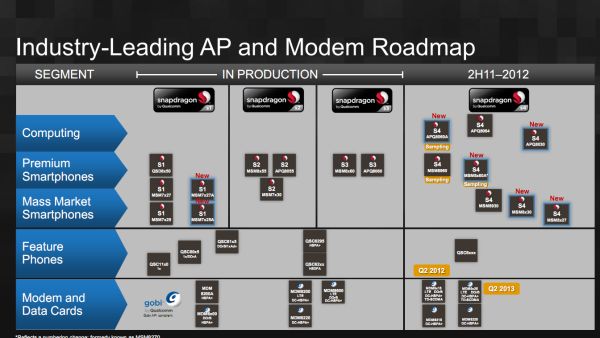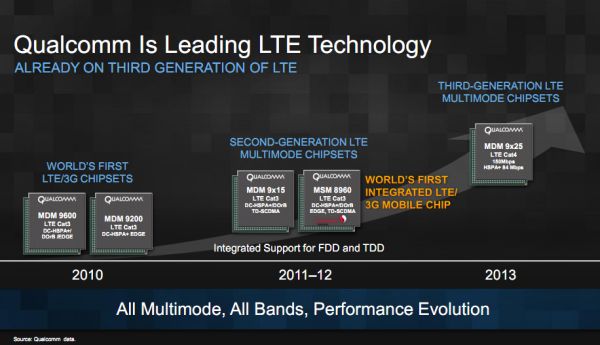Qualcomm Announces a Bunch of Krait Based Snapdragon S4 SoCs
by Anand Lal Shimpi on November 16, 2011 11:49 AM EST- Posted in
- Smartphones
- Snapdragon
- Qualcomm
- Krait
- Mobile
- SoCs
In February at MWC, Qualcomm unveiled three SoCs based on its brand new Krait microarchitecture: the single/dual-core MSM8930, dual-core MSM8960 and the quad-core APQ8064. More recently, we dove into Krait's architecture - a Cortex A15 class, generational improvement over Qualcomm's current Scorpion core. Today at its analyst day, Qualcomm announced five more Krait based SoCs to flesh out the roadmap.
As a refresher, the MSM prefix in Qualcomm's naming system implies an integrated baseband (3G, 4G and/or LTE). The APQ prefix on the other hand means the SoC has no integrated baseband.
The MSM8960 is going to be first out of the gate. A high end SoC, the 8960 features two Krait cores running at up to 1.7GHz (initial debut will be at 1.5GHz). In order to improve time to market, Qualcomm paired the 8960 with its Adreno 225 GPU. The SoC has two LPDDR2 channels running at up to 500MHz (1GHz datarate). Finally the 8960 includes Qualcomm's 3G/4G/LTE baseband on-die. The entire SoC is built on a 28nm process, which should finally deliver decent battery life when deployed in an LTE phone.
If you want an 8960 without integrated LTE, Qualcomm has an SoC for you: the MSM8x60A. The CPU specs are the same as the 8960, just without LTE support.
Below the 8960 is the MSM8930, a dual-core Krait (up to 1.2GHz) offering with only a single LPDDR2 memory channel (up to 1066MHz data rate). The 8930 will actually use a faster GPU than the 8960, the Adreno 305, although it'll be more memory bandwidth limited. The 8930 will also debut later than the 8960 partially due to its new GPU.
The 8930 features LTE support, but if you want a version without it there's the new MSM8x30. Similarly, if you want a version without an integrated baseband altogether there's the APQ8030. The ISP in the xx30 series supports 1080p video decode and up to a 13.5MP camera (down from 20MP in the xx60 SoCs).
There's an even even more affordable S4 in the lineup: the MSM8x27. Here you get two Krait cores running at up to 1GHz, a single channel LPDDR2 interface (800MHz max data rate). Video decode is limited to 720p in the 8x27.
The APQ8064, MSM8x30 and MSM8x27 parts won't be out until the latter part of 2012.
Although it's not new, the APQ8064 is also on the roadmap. The 8064 is a quad-core Krait SoC, clock speeds are once again limited to 1.7GHz initially (the SoC will eventually scale to much higher speeds). The memory interface grows to support standard DDR3-1066. The SoC also has on-die SATA and PCIe controllers, making it an obvious target for Windows 8 based systems.
The entire Krait roadmap looks very strong. Qualcomm is clearly trying to bring LTE and Krait mainstream. I'm not sure how much competition Krait will see until OMAP 5 devices show up in the latter part of 2012, unless Apple decides to put out a Cortex A15 A6 SoC earlier. NVIDIA has already shown its hand with Tegra 3, and Wayne won't show up until late next year as well.
All of the aforementioned SoCs fall under Qualcomm's Snapdragon S4 brand. The S4 label refers to Krait based solutions exclusively. In addition to the new S4s, Qualcomm also mentioned that it's hard at work on its third generation LTE chipset: the MDM9x25 with support for LTE Category 4.












5 Comments
View All Comments
andrewsdw - Wednesday, November 16, 2011 - link
I am still on my old 3gs...I cannot wait until I am able to switch to either a Exynos 4212 or a S4 based phone! Tegra 3 looks to be to much of a hog for me. I think the 4 cores will be less useful than a higher speed dual core with proper video decoding and lower power usage.B3an - Friday, November 18, 2011 - link
Just because a SoC has less cores dont mean it has lower power usage. The Tegra 3 has a 5th core that only runs when the phone is locked / not in use. And that core uses less power than any dual core SoC's that i know of.bjacobson - Friday, November 18, 2011 - link
4 cores though. Who needs that? We need 2. One for everything except for the foreground application, and one for the foreground application. I don't see this changing in 2012. The higher clock dual core will have sufficiently low power usage. Yes, during idle T3 may be lower, but it won't matter.eddman - Wednesday, November 16, 2011 - link
Isn't APQ8060 an S3 snapdragon? HP TouchPad, T-Mobile Galaxy S II and Galaxy S II Skyrocket already have it.So I guess you meant that APQ8064 won't be out until the latter part of 2012, right? I thought it'd come in 1H 2012.
Also, where is MSM8974?
RBurman - Wednesday, April 5, 2017 - link
MSM8974 Registers Description details or APQ 8074 Registers Description details(for d/l pl.)